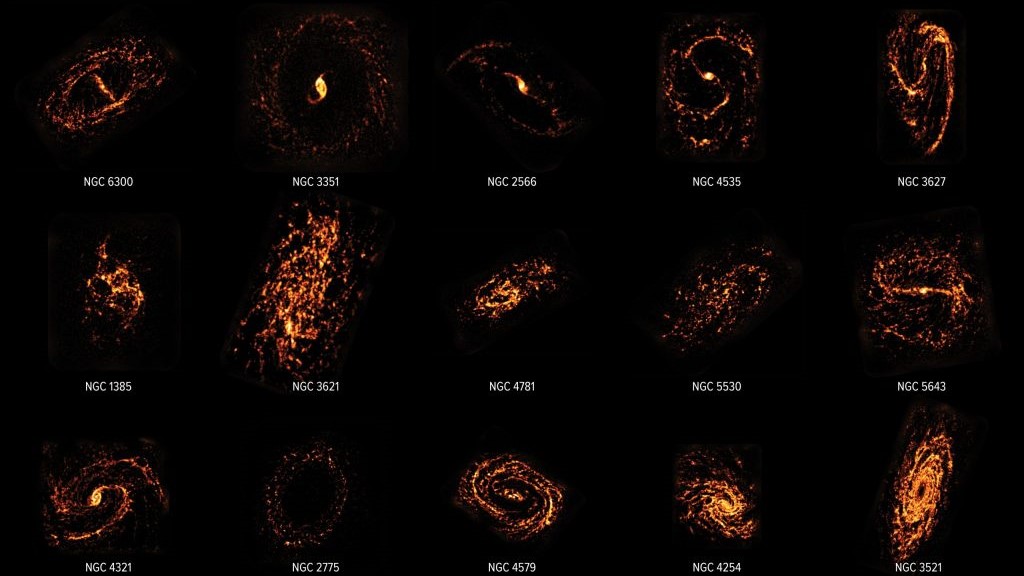When you buy through inter-group communication on our site , we may pull in an affiliate commission . Here ’s how it work .
Stellar nursery , the cauldron of gas and debris where stars are forged , are far more diverse than astronomers first thought , allot to a unexampled , first - of - its kind survey .
uranologist at the Physics at High Angular Resolution in Nearby Galaxies ( PHANGS ) projection have systematically charted more than 100,000 nurseries across 90 galaxies , and see that each one is far more unique than first thought .

Here, a few of the stellar nurseries mapped in the ALMA survey.
star can take tens of one thousand thousand of years to form — growing from heave clouds of roily junk and gas into softly glow protostars , before finally materialise into gigantic orb of fusion - powered plasma like our sunshine . But how quickly this appendage deplete a nursery ’s storage of gas and dust , and how many star are later on able-bodied to form in a given place , depends on a stellar baby’s room ’s localization in a galaxy .
Related : The 12 strange objects in the universe
" We used to think that all stellar baby’s room across every galaxy must look more or less the same , but this survey has revealed that this is not the case , and starring greenhouse change from place to place , " lead author Adam Leroy , associate professor of astronomy at The Ohio State University , said in a statement . " These nurseries are responsible for building Galax urceolata and making satellite , and they ’re just an essential part in the report of how we get here . "

NGC4535, a spiral and stellar bar galaxy, was also included in the survey.
The five - year sight , conducted across a section of the macrocosm know as the nearby universe because of its proximity to our own galaxy , used the Atacama Large Millimeter / Submillimeter Array ( ALMA ) radio telescope locate in Chile’sAtacama Desert . By impart their survey in theradiopart of theelectromagnetic spectrum , rather than the optic part , the astronomers could focus on the faint glowing from the dust and gas of the morose and heavy molecular clouds , as oppose to the visible lighter from the young stars birthed by them .
This allowed the researchers to analyze how a star ’s home cloud determine its establishment .
" To understand how stars human body , we need to link the nativity of a single star back to its lieu in the universe . It ’s like linking a person to their home , neighborhood , metropolis and region . If a galaxy exemplify a city , then the neighborhood is the spiral branch , the house the wiz - forming unit , and nearby galaxies are neighbour cities in the region , " PHANGS main investigator Eva Schinnerer , an astronomer at the Max Planck Institute for Astronomy , suppose in the statement . " These observations have taught us that the ' neighborhood ' has small but pronounced event on where and how many headliner are bear . "

A small selection of the 90 galaxies included in ALMA’s survey.
They bump that champion are forge differently depending on whether the molecular clouds that make them are located in astronomical disc , stellar bar , spiral arm or astronomical centers .
" Clouds in the heavy central regions of wandflower incline to be more massive , denser and more turbulent than clouds that occupy in the quiet outskirts of a galaxy , " said conscientious objector - writer Annie Hughes , an stargazer at L’Institut de Recherche en Astrophysique et Planétologie . " The life-time Hz of clouds also depends on their environment . How fast a swarm forms stars and the process that ultimately destroys the swarm both seem to depend on where the cloud survive . "
Next , the team will seek to see out what this variation could entail for the constitution of adept and planets , as well as for our own berth in the universe .

— The 18 biggest unsolved mysteries in cathartic
— From Big Bang to face : Snapshots of our universe of discourse through meter
— 15 amazing images of wizard

" This is the first time we have get a clear view of the population of astral nurseries across the whole nearby universe . In that sense , it ’s a big step towards intellect where we add up from , " Leroy say in the statement . " While we now love that astral nurseries vary from spot to place , we still do not have intercourse why or how these sport affect the stars and planets formed . These are motion that we hope to reply in the near future . "
The investigator presented their finding on Tuesday ( June 8) at the online summertime group meeting of the American Astronomical Society , and they published their finding April 15 on the preprint serverarXiv , so the study has yet to be match - reviewed .
in the first place published on Live Science .













